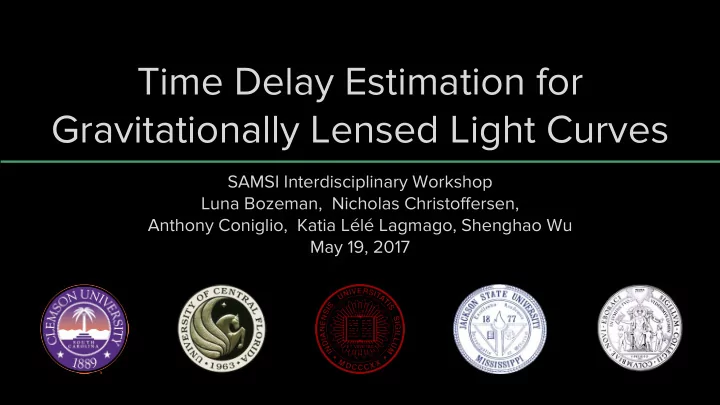

Time Delay Estimation for Gravitationally Lensed Light Curves SAMSI Interdisciplinary Workshop Luna Bozeman, Nicholas Christoffersen, Anthony Coniglio, Katia Lélé Lagmago, Shenghao Wu May 19, 2017
Outline ● Introduction: Gravitational Lensing Nonparametric methods with bootstrapping ● � 2 Optimization ○ ○ Pelt’s Method ○ Cross-correlation Parametric methods ● ○ Maximum Likelihood Estimation ○ Bayesian ● Conclusion: Comparison of All Methods
Gravitational Lensing ● Gravitational field of a galaxy can act as a lens and deflect light. ● Gravitational lensing causes duplicate images of the same object in the sky. ● Fluctuations in brightness are observed in the images at different times. Goal: Estimate time delays for gravitationally lensed light curves using ● various non-parametric and parametric methods. Image Credit: German Aerospace Center
Conceptualization Image Credit: Rochester Institute of Technology
Non-parametric Method: � 2 Optimization Define a function: Then, find the value of Δ that minimizes: Utilizes bootstrapping to calculate the uncertainty quantification.
Our Data
Non-parametric Method: Pelt Method Very similar to the � 2 method. ● Vertically shift the time series ontop of one another, then shift it by some Δ ● ● Now check the sum of the square differences from one data point to the next, not interpolating between data points ● Find the value of delta that minimizes this sum of square differences
Non-parametric Method: Pelt’s second order method ● A more complicated model: taking into consideration the measurement error and which light curve two consecutive points belong to ● Find Δ to minimize the loss function D (a function of Δ)
� 2 vs Pelt Method
Non-parametric Method: Cross Correlation ● A method that takes two time series and shifts one of them by a delay, Δ, then calculates how similar in behavior they are at every Δ by the formula below. ● Use the Δ that provides the highest cross correlation value as our estimate for the true time delay between the two time series. ● Utilize bootstrapping to create a tolerance on the estimate of time delay.
Time Delay Estimation
When Can Cross Correlation Fail? Good! Bad Clear patterns with lots of movement. No clear pattern. Looks like “white noise”. ● ● ● Minimal seasonal gaps. ● Minimal fluctuations. Large seasonal gaps. ●
When Can Cross Correlation Fail? Good! Bad One clearly defined peak. A lot of noise with no defined peak. ● ● ● High maximum cross correlation value. ● Low maximum cross correlation value.
Parametric Method: Maximum Likelihood Estimation (MLE) ● Likelihood function : joint probability density function; five parameters ● Goal: to find the optimal five-tuple that maximizes the likelihood function.
MLE as an optimization problem ● Hard to do optimization over a 5-d space: nonconvex, multimodal objective function; hill-climbing optimization trapped at local optimum ● Fails unless reasonable initial point is given ● Instead, we maximize the profile likelihood ● Grid search: set the grid for Δ in (-100, 100) with grid size=0.01 ● First maximize the likelihood for each Δi (compute ) ● Then find the Δ that maximizes
Profile likelihood maximization ● Mean of the Estimate: ● Variance:
Performance MLE may fail when the estimate is close to the marginal value (e.g. ≅ -100)
When does it fail: noisy dataset with large seasonal gaps Bad Data: Normalized Log Profile likelihood: ● low SNR ● Could blow up when one timeseries is ● large seasonal gap right below the gap of the other (when ● Shifted time series may lie delta is about -100) right below the seasonal gap ● Optimal at the margin. of the other
Parametric Model: Bayesian Approach ● Using programming language R, we were able to install its “timedelay” package to evaluate the different data sets given. ● Using the code and the data provided with the specific instructions, we obtained the posterior distribution of the time delay (mean and standard deviation values) Mean value and standard deviation representing estimate and uncertainty, ● respectively ● The obtained values were then compared to the true values ● The mean squared errors were obtained with the formula:
The Bayesian Approach Other methods follow a separate procedure ● for point estimation and uncertainty quantification ● Bayesian derives both the point estimate and uncertainty from the posterior distribution. (see histogram) ● Downfall: Takes a lot of time
Conclusion: Comparison of All Methods
Conclusion: Comparison of All Methods
Acknowledgements ● We would like to first and foremost thank SAMSI for providing us with the opportunity to participate in this workshop. ● We would also like to thank NCSU for hosting us during the workshop. ● Last but not least, we would like to thank Hyungsuk Tak for his mentorship and guidance through this project.
Reference [1] Fassnacht, C. D., et al. "A determination of H0 with the CLASS gravitational lens B1608+ 656. I. Time delay measurements with the VLA." The Astrophysical Journal 527.2 (1999): 498. [2] H. Tak, K. Mandel, D. A. van Dyk, V. Kashyap, X. Meng, and A. Siemiginowska (2017+) “Bayesian and Profile Likelihood Strategies for Time Delay Estimation from Stochastic Time Series of Gravitationally Lensed Quasars” [3] H. Tak, K. Mandel, D. A. van Dyk, V. Kashyap, X. Meng, and A. Siemiginowska (2015) “time delay”, R package. [4] Pelt, Jaan, et al. "The light curve and the time delay of QSO 0957+ 561." arXiv preprint astro-ph/9501036 (1995).
Recommend
More recommend